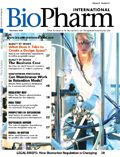The New Era of Process Validation
The FDA's revised process validation guidance manages to explain the underlying concepts of Quality by Design without every using the phrase.
Old-style process validation has finally died. Or at least, that should be the result of the FDA's draft revision of the 1987 guidance on the topic, which has finally been released after a long wait.

Laura Bush
This means no more hoping desperately for three good batches, and no more "validating" poorly understood processes. What is replacing the old way is an approach based on in-depth process understanding and the knowledge that validation cannot end with filing. Validation is not an event; it is a process.
Few people who have been listening to the agency for the last few years are surprised by what appears in the new guidance document. And of course, many companies have been doing it the "new" way for some time. But far from all companies do so; there are still some big gaps. Just spend a few minutes talking to any industry consultant, and you will soon hear horror stories about companies using unscientific methods or simply missing the point altogether.
So for those who haven't yet grasped the current way of thinking, the new guidance makes it all clear. It starts with the definition of process validation as
. . . the collection and evaluation of data, from the process design stage throughout production, which establishes scientific evidence that a process is capable of consistently delivering quality products.
Note the emphasis on data, a word mentioned 32 times in the document. Also note that "the collection and evaluation of data" replaces the phrase "documented evidence" from the 1987 definition. Too often, firms interpreted that latter phrase to mean simply recording three successful batches.
The guidance then explains that process validation is accomplished in three stages: 1) process design (process development and scale up); 2) process qualification (confirming the design); and 3) continued process verification (ongoing monitoring of commercial production). By presenting these three stages, the agency has shifted the focus from the actual testing at commercial scale to what comes before (gaining process understanding) and after (ongoing process control).
After reading this guidance document, one cannot doubt that process validation is about two fundamental things: understanding your process, and then ensuring it remains in a state of control.
That, of course, is also what Quality by Design is all about. Yet the term "quality by design" does not appear anywhere, and the document makes only passing reference to ICH Q8, Q9, and Q10—in a footnote.
That, in fact, may be the agency's biggest coup. Because this guidance manages to explain the underlying concepts of Quality by Design without ever using the phrase. And the explanation of what is expected is so straightforward that it should make sense even to those who dismiss Quality by Design as a vague concept, just a buzzword, or, on the contrary, as something too complex and expensive to take on.
And although QbD skeptics may never describe a "design space" in a regulatory filing, if they follow the spirit of this guidance, they will be undertaking the fundamentally scientific approach to ensuring product quality that is at the heart of QbD. And regardless of the terminology, that is what the FDA has been trying to achieve through all its initiatives over the past half decade. Perhaps with this move, the message will be understood by everyone, once and for all.
Laura Bush is the editor in chief of BioPharm International, lbush@advanstar.com

Newsletter
Stay at the forefront of biopharmaceutical innovation—subscribe to BioPharm International for expert insights on drug development, manufacturing, compliance, and more.
Pfizer Obtains Exclusive Rights to 3SBio’s Bispecific Antibody Targeting PD-1 and VEGF
July 25th 2025The licensing agreement between the two companies gives Pfizer the rights to develop, manufacture, and commercialize 3SBio’s bispecific antibody, SSGJ-707, which is in clinical trials for the treatment of a variety of cancers.